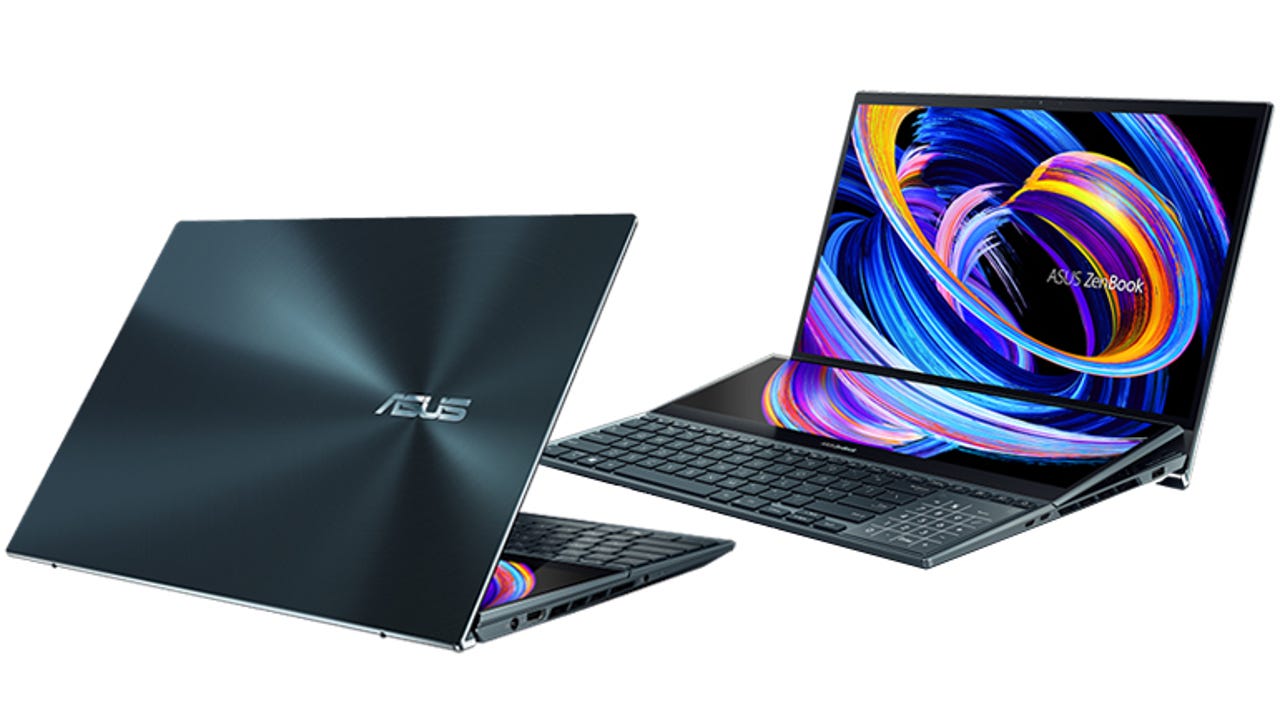































 ASUS
ASUS It's been over two years since Microsoft first tantalized us with the prospect of Windows 10X and the Surface Neo. While the Neo is still not officially dead (it wouldn't be the only Neo to be resurrected), Windows has moved on.
Our recommended models for every use case and platform.
Read nowNow, other Windows PC makers are working on dual-screened laptops that offer different takes on Microsoft's concept.
Indeed, with a Core i9 processor and powerful Nvidia RTX discrete graphics processor, theASUS ZenBook Pro Duo offers the kind of muscle one would expect in a modern workstation. It would merely be a capable clamshell, however, if it didn't have the feature that other mobile PCs for creative pros lack: a second screen.
That display, the ScreenPad+, is a high-resolution OLED touchscreen that lives between the main screen and the keyboard, spanning the width of the device. Despite its odd aspect ratio, it offers the most significantly differentiating feature offered on a laptop in years, one that easily eclipses the advent of either Yoga-style or Surface-style 2-in-1s.
Particularly on a beast of a laptop like the Duo Pro, which is designed to accommodate apps with multiple palettes or pop-out interface components, the ScreenPad+ provides a convenient home for offloading interface clutter. A great example of this is Adobe's Premiere Pro, where one can pop out the timeline panel and move it to the ScreenPad+. Its short, wide shape is a great fit for working with timelines or music tracks in digital audio workstation software.
Read our ASUS ZenBook Pro Duo 15 OLED review
But even for those working with less dynamic media forms, the ScreenPad+ proves useful. Writers doing online research, for example, can take advantage of the main screen for corralling multiple web, keeping a few paragraphs visible in a word processor on the second screen. Students can include a note-taking app on the lower screen, too. In fact, those who don't need the horsepower of the ZenBook Pro Duo can pick up the smaller and less expensive14-inch ZenBook Duo .
The ScreenPad+ doesn't offer as much extra working room as a full-sized monitor sitting next to the laptop. But what it lacks in display area, it compensates for in both design and functional integration. The challenge with many brand-specific device features is that their utility stretches only as far as developer support. In contrast, it's easy for any Windows app that supports multiple windows to find a use for the ScreenPad+. ASUS has also developed windowing enhancements that allow for the docking of multiple windows on the second screen.
Such utility must be justified; the extra display forces the most significant, ergonomic layout change since the earliest PowerBooks pushed the keyboard toward the top of the clamshell's lower deck to accommodate the trackball (and, later, the trackpad). Taking advantage of the machine's width, the ZenBook Pro Duo moves the trackpad to the right of the keyboard and adds an optional light-up keypad overlay.
However, the trackpad reshuffling may not be welcomed by lefties.
There is further room for improvement. For one, even with ASUS' clever hinge that elevates its ScreenPad+ when you open the notebook, the viewing angle is still a bit low for extended work. ASUS includes a stand add-on that affixes to the bottom of the notebook to raise it further, as well as a wrist rest add-on designed to compensate for the lack of elevation in front of the keyboard. But these make the experience clunkier.
Even if the viewing angle could be improved, a ScreenPad-like lower screen would pose challenges on smaller laptops. That said, as laptop screen ratios return to taller aspect ratios like 16:10 and 3:2, including a second display (sized between Apple's now-abandoned Touch Bar and the ScreenPad+) would be worth cutting into trackpad sizes that have grown to the point of diminishing returns.
 Hot Tags :
Tech
Our process
Computing
Laptops
Hot Tags :
Tech
Our process
Computing
Laptops